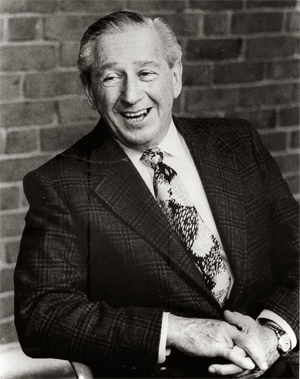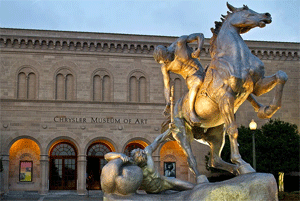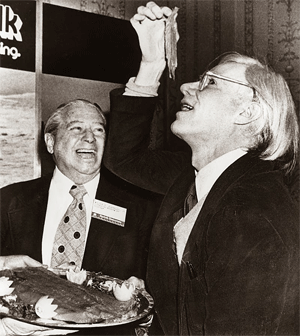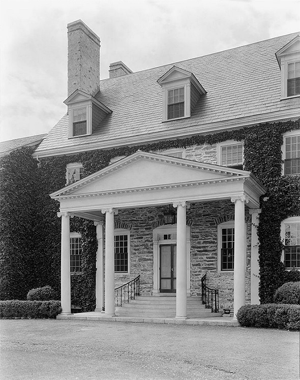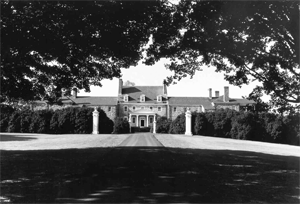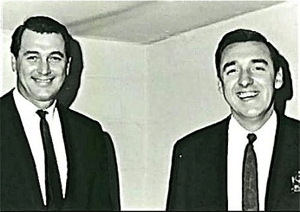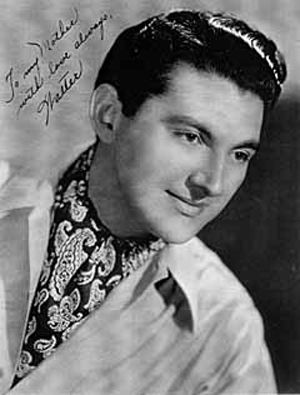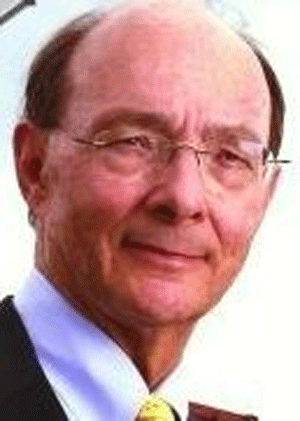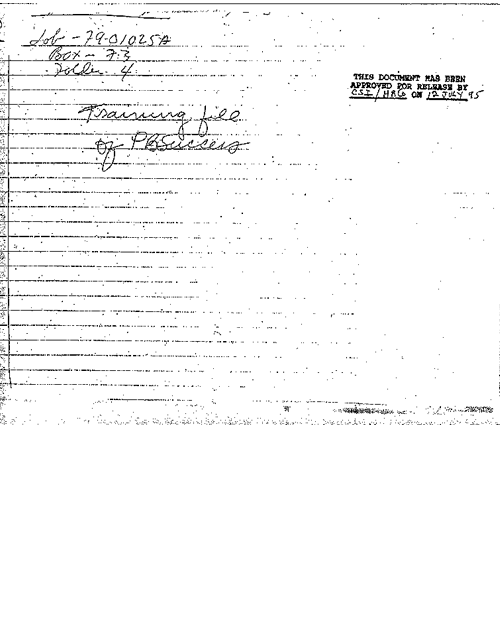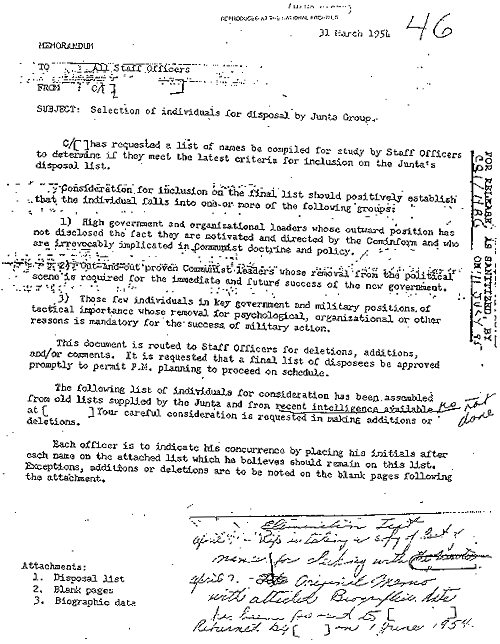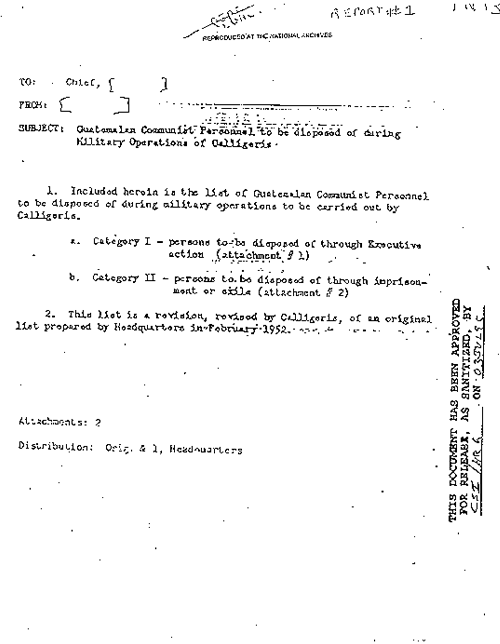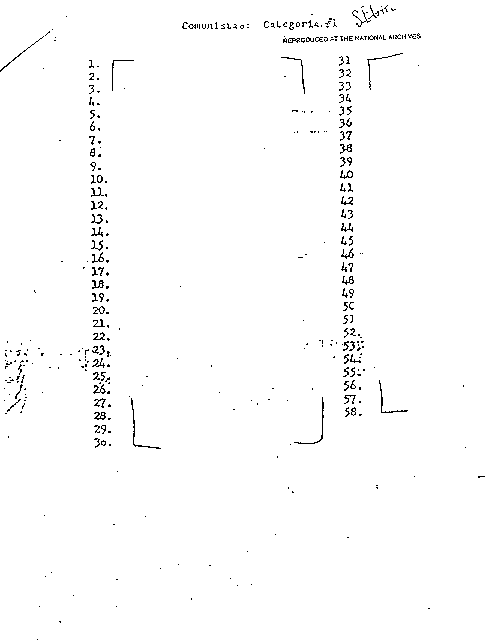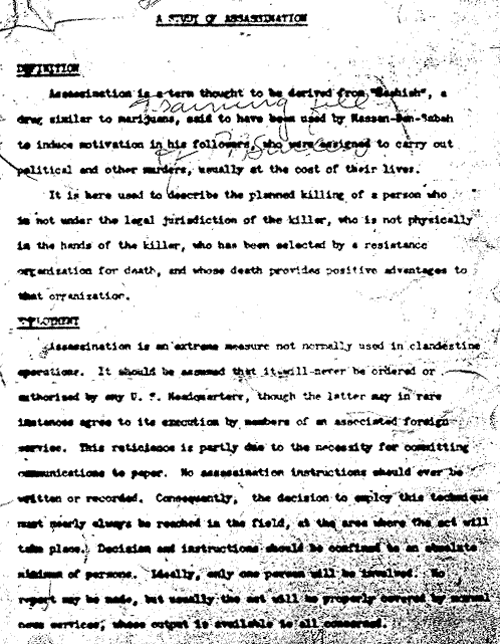 A STUDY OF ASSASSINATION
A STUDY OF ASSASSINATION
DEFINITIONAssassination is a term thought to be derived from "Hashish", a drug similar to marijuana, said to have been used by Hasan-Bin-Sabah to induce motivation in his followers, who were assigned to carry out political and other murders, usually at the cost of their lives.
It is here used to describe the planned killing of a person who is not under the legal jurisdiction of the killer, who is not physically in the hands of the killer, who has been selected by a resistance organization for death, and whose death provides positive advantages to that organization.
EMPLOYMENTAssassination is an extreme measure not normally used in clandestine operations. It should be assumed that it will never be ordered or authorized by any U.S. Headquarters, though the latter may in rare instances agree to its execution by members of an associated foreign service. This reticence is partly due to the necessity for committing communications to paper. No assassination instructions should ever be written or recorded. Consequently, the decision to employ this technique must nearly always be reached in the field, at the area where the act will take place. Decision and instructions should be confined to an absolute minimum of persons. Ideally, only one person will be involved. No report may be made, but usually the act will be properly covered by normal news services, whose output is available to all concerned.
JUSTIFICATIONMurder is not morally justifiable. Self-defense may be argued if the victim has knowledge which may destroy the resistance organization if divulged. Assassination of persons responsible for atrocities or reprisals may be regarded as just punishment. Killing a political leader whose burgeoning career is a clear and present danger to the cause of freedom may be held necessary.
But assassination can seldom be employed with a clear conscience. Persons who are morally squeamish should not attempt it.
CLASSIFICATIONSThe techniques employed will vary according to whether the subject is unaware of his danger, aware but unguarded, or guarded. They will also be affected by whether or not the assassin is to be killed with the subject. Hereafter, assassinations in which the subject is unaware will be termed "simple"; those where the subject is aware but unguarded will be termed "chase"; those where the victim is guarded will be termed "guarded."
If the assassin is to die with the subject, the act will be called "lost." If the assassin is to escape, the adjective will be "safe." It should be noted that no compromises should exist here. The assassin must not fall alive into enemy hands.
A further type division is caused by the need to conceal the fact that the subject was actually the victim of assassination, rather than an accident or natural causes. If such concealment is desirable the operation will be called "secret"; if concealment is immaterial, the act will be called "open"; while if the assassination requires publicity to be effective it will be termed "terroristic."
Following these definitions, the assassination of Julius Caesar was safe, simple, and terroristic, while that of Huey Long was lost, guarded and open. Obviously, successful secret assassinations are not recorded as assassination at all. [Illeg] of Thailand and Augustus Caesar may have been the victims of safe, guarded and secret assassination. Chase assassinations usually involve clandestine agents or members of criminal organizations.
THE ASSASSINIn safe assassinations, the assassin needs the usual qualities of a clandestine agent. He should be determined, courageous, intelligent, resourceful, and physically active. If special equipment is to be used, such as firearms or drugs, it is clear that he must have outstanding skill with such equipment.
Except in terroristic assassinations, it is desirable that the assassin be transient in the area. He should have an absolute minimum of contact with the rest of the organization and his instructions should be given orally by one person only. His safe evacuation after the act is absolutely essential, but here again contact should be as limited as possible. It is preferable that the person issuing instructions also conduct any withdrawal or covering action which may be necessary.
In lost assassination, the assassin must be a fanatic of some sort. Politics, religion, and revenge are about the only feasible motives. Since a fanatic is unstable psychologically, he must be handled with extreme care. He must not know the identities of the other members of the organization, for although it is intended that he die in the act, something may go wrong. While the assassin of Trotsky has never revealed any significant information, it was unsound to depend on this when the act was planned.
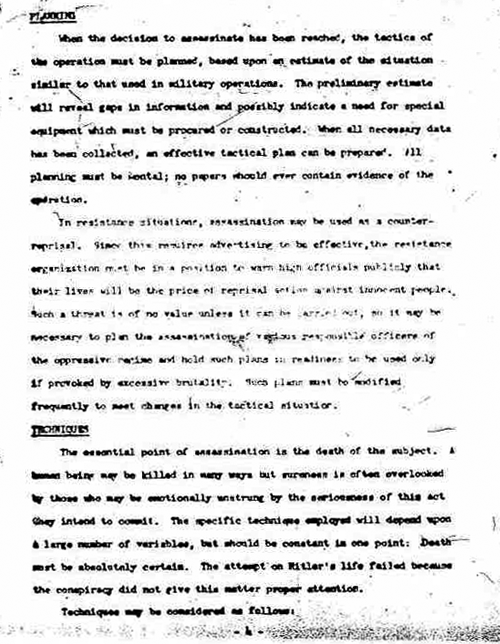 PLANNING
PLANNINGWhen the decision to assassinate has been reached, the tactics of the operation must be planned, based upon an estimate of the situation similar to that used in military operations. The preliminary estimate will reveal gaps in information and possibly indicate a need for special equipment which must be procured or constructed. When all necessary data has been collected, an effective tactical plan can be prepared. All planning must be mental; no papers should ever contain evidence of the operation.
In resistance situations, assassination may be used as a counter-reprisal. Since this requires advertising to be effective, the resistance organization must be in a position to warn high officials publicly that their lives will be the price of reprisal action against innocent people. Such a threat is of no value unless it can be carried out, so it may be necessary to plan the assassination of various responsible officers of the oppressive regime and hold such plans in readiness to be used only if provoked by excessive brutality. Such plans must be modified frequently to meet changes in the tactical situation.
TECHNIQUESThe essential point of assassination is the death of the subject. A human being may be killed in many ways but sureness is often overlooked by those who may be emotionally unstrung by the seriousness of this act they intend to commit. The specific technique employed will depend upon a large number of variables, but should be constant in one point: Death must be absolutely certain. The attempt on Hitler's life failed because the conspiracy did not give this matter proper attention.
Techniques may be considered as follows:
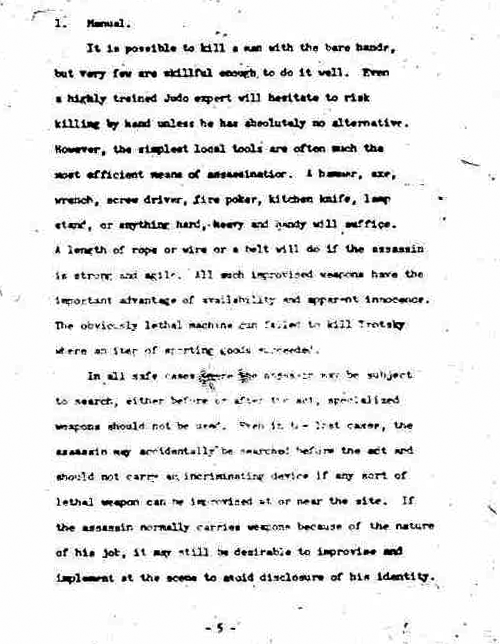 1. Manual.
1. Manual.It is possible to kill a man with the bare hands, but very few are skillful enough to do it well. Even a highly trained Judo expert will hesitate to risk killing by hand unless he has absolutely no alternative. However, the simplest local tools are often much the most efficient means of assassination. A hammer, axe, wrench, screw driver, fire poker, kitchen knife, lamp stand, or anything hard, heavy and handy will suffice. A length of rope or wire or a belt will do if the assassin is strong and agile. All such improvised weapons have the important advantage of availability and apparent innocence. The obviously lethal machine gun failed to kill Trotsky where an item of sporting goods succeeded.
In all safe cases where the assassin may be subject to search, either before or after the act, specialized weapons should not be used. Even in the lost case, the assassin may accidentally be searched before the act and should not carry an incriminating device if any sort of lethal weapon can be improvised at or near the site. If the assassin normally carries weapons because of the nature of his job, it may still be desirable to improvise and implement at the scene to avoid disclosure of his identity.
2. Accidents.For secret assassination, either simple or chase, the contrived accident is the most effective technique. When successfully executed, it causes little excitement and is only casually investigated.
The most efficient accident, in simple assassination, is a fall of 75 feet or more onto a hard surface. Elevator shafts, stair wells, unscreened windows and bridges will serve. Bridge falls into water are not reliable. In simple cases a private meeting with the subject may be arranged at a properly-cased location. The act may be executed by sudden, vigorous [excised] of the ankles, tipping the subject over the edge. If the assassin immediately sets up an outcry, playing the "horrified witness", no alibi or surreptitious withdrawal is necessary. In chase cases it will usually be necessary to stun or drug the subject before dropping him. Care is required to ensure that no wound or condition not attributable to the fall is discernible after death.Falls into the sea or swiftly flowing rivers may suffice if the subject cannot swim. It will be more reliable if the assassin can arrange to attempt rescue, as he can thus be sure of the subject's death and at the same time establish a workable alibi.
If the subject's personal habits make it feasible, alcohol may be used [2 words excised] to prepare him for a contrived accident of any kind.Falls before trains or subway cars are usually effective, but require exact timing and can seldom be free from unexpected observation.
Automobile accidents are a less satisfactory means of assassination. If the subject is deliberately run down, very exact timing is necessary and investigation is likely to be thorough. If the subject's car is tampered with, reliability is very low. The subject may be stunned or drugged and then placed in the car, but this is only reliable when the car can be run off a high cliff or into deep water without observation.
Arson can cause accidental death if the subject is drugged and left in a burning building. Reliability is not satisfactory unless the building is isolated and highly combustible.
3. Drugs.In all types of assassination except terroristic,
drugs can be very effective. If the assassin is trained as a doctor or nurse and the subject is under medical care, this is an easy and rare method. An overdose of morphine administered as a sedative will cause death without disturbance and is difficult to detect. The size of the dose will depend upon whether the subject has been using narcotics regularly. If not, two grains will suffice.
If the subject drinks heavily, morphine or a similar narcotic can be injected at the passing out stage, and the cause of death will often be held to be acute alcoholism.Specific poisons, such as arsenic or strychine, are effective but their possession or procurement is incriminating, and accurate dosage is problematical. Poison was used unsuccessfully in the assassination of Rasputin and Kolohan, though the latter case is more accurately described as a murder.
4. Edge Weapons.Any locally obtained edge device may be successfully employed. A certain minimum of anatomical knowledge is needed for reliability.
Puncture wounds of the body cavity may not be reliable unless the heart is reached. The heart is protected by the rib cage and is not always easy to locate.Abdominal wounds were once nearly always mortal, but modern medical treatment has made this no longer true.
Absolute reliability is obtained by severing the spinal cord in the cervical region. This can be done with the point of a knife or a light blow of an axe or hatchet.
Another reliable method is the severing of both jugular and carotid blood vessels on both sides of the windpipe.If the subject has been rendered unconscious by other wounds or drugs, either of the above methods can be used to ensure death.
5. Blunt Weapons.As with edge weapons, blunt weapons require some anatomical knowledge for effective use. Their main advantage is their universal availability. A hammer may be picked up almost anywhere in the world. Baseball and [illeg] bats are very widely distributed. Even a rock or a heavy stick will do, and nothing resembling a weapon need be procured, carried or subsequently disposed of.
Blows should be directed to the temple, the area just below and behind the ear, and the lower, rear portion of the skull. Of course, if the blow is very heavy, any portion of the upper skull will do. The lower frontal portion of the head, from the eyes to the throat, can withstand enormous blows without fatal consequences.
6. Firearms.Firearms are often used in assassination, often very ineffectively. The assassin usually has insufficient technical knowledge of the limitations of weapons, and expects more range, accuracy and killing power than can be provided with reliability. Since certainty of death is the major requirement,
firearms should be used which can provide destructive power at least 100% in excess of that thought to be necessary, and ranges should be half that considered practical for the weapon.Firearms have other drawbacks. Their possession is often incriminating. They may be difficult to obtain. They require a degree of experience from the user. They are [illeg]. Their [illeg] is consistently over-rated.
However, there are many cases in which firearms are probably more efficient than any other means. These cases usually involve distance between the assassin and the subject, or comparative physical weakness of the assassin, as with a woman.
(a) The precision rifle.
In guarded assassination, a good hunting or target rifle should always be considered as a possibility. Absolute reliability can nearly always be achieved at a distance of one hundred yards. In ideal circumstances, the range may be extended to 250 yards.
The rifle should be a well made bolt or falling block action type, handling a powerful long-range cartridge. The .300 F.A.B. Magnum is probably the best cartridge readily available. Other excellent calibers are . 375 M.[illeg]. Magnum, .270 Winchester, .30 - 106 p.s., 8 x 60 MM Magnum, 9.3 x 62 kk and others of this type. These are preferable to ordinary military calibers, since ammunition available for them is usually of the expanding bullet type, whereas most ammunition for military rifles is full jacketed and hence not sufficiently lethal. Military ammunition should not be altered by filing or drilling bullets, as this will adversely affect accuracy.
The rifle may be of the "bull gun" variety, with extra heavy barrel and set triggers, but in any case should be capable of maximum precision. Ideally, the weapon should be able to group in one inch at one hundred yards, but 2 1/2" groups are adequate.
The sight should be telescopic, not only for accuracy, but because such a sight is much better in dim light or near darkness. As long as the bare outline of the target is discernable, a telescope sight will work, even if the rifle and shooter are in total darkness.
An expanding, hunting bullet of such calibers as described above will produce extravagant laceration and shock at short or mid-range. If a man is struck just once in the body cavity, his death is almost entirely certain.Public figures or guarded officials may be killed with great reliability and some safety if a firing point can be established prior to an official occasion. The propaganda value of this system may be very high.
(b) The machine gun.
Machine guns may be used in most cases where the precision rifle is applicable. Usually, this will require the subversion of a unit of an official guard at a ceremony, though a skillful and determined team might conceivably dispose of a loyal gun crew without commotion and take over the gun at the critical time.
The area fire capacity of the machine gun should not be used to search out a concealed subject. This was tried with predictable lack of success on Trotsky.
The automatic feature of the machine gun should rather be used to increase reliability by placing a 5 second burst on the subject. Even with full jacket ammunition, this will be absolute lethal if the burst pattern is no larger than a man. This can be accomplished at about 150 yards. In ideal circumstances, a properly padded and targeted machine gun can do it at 850 yards. The major difficulty is placing the first burst exactly on the target, as most machine gunners are trained to spot their fire on target by observation of strike. This will not do in assassination as the subject will not wait.
(c) The Submachine Gun.
This weapon, known as the "machine-pistol" by the Russians and Germans and "machine-carbine" by the British, is occasionally useful in assassination. Unlike the rifle and machine gun, this is a short range weapon and since it fires pistol ammunition, much less powerful.
To be reliable, it should deliver at least 5 rounds into the subject's chest, though the .45 caliber U.S. weapons have a much larger margin of killing efficiency than the 9 mm European arms.
The assassination range of the sub-machine gun is point blank. While accurate single rounds can be delivered by sub-machine gunners at 50 yards or more, this is not certain enough for assassination. Under ordinary circumstances,
the SMG should be used as a fully automatic weapon. In the hands of a capable gunner, a high cyclic rate is a distinct advantage, as speed of execution is most desirable, particularly in the case of multiple subjects.The sub-machine gun is especially adapted to indoor work when more than one subject is to be assassinated. An effective technique has been devised for the use of a pair of sub-machine gunners, by which
a room containing as many as a dozen subjects can be "purified" in about twenty seconds with little or no risk to the gunners. It is illustrated below.
While the U.S. sub-machine guns fire the most lethal cartridges, the higher cyclic rate of some foreign weapons enable the gunner to cover a target quicker with acceptable pattern density. The Bergmann Model 1934 is particularly good in this way. The Danish Madsen SMG has a moderately good cyclic rate and is admirably compact and concealable. The Russian SHGs have a good cyclic rate, but are handicapped by a small, light projectile which requires more hits for equivalent killing effect.
(d) The Shotgun.
A large bore shotgun is a most effective killing instrument as long as the range is kept under ten yards. It should normally be used only on single targets as it cannot sustain fire successfully. The barrel may be "sawed" off for convenience, but this is not a significant factor in its killing performance.
Its optimum range is just out of reach of the subject. 00 buckshot is considered the best shot size for a twelve gauge gun, but anything from single balls to bird shot will do if the range is right.
The assassin should aim for the solar plexus as the shot pattern is small at close range and can easily [illeg] the head.(e) The Pistol.
While the handgun is quite inefficient as a weapon of assassination, it is often used, partly because it is readily available and can be concealed on the person, and partly because its limitations are not widely appreciated. While many well known assassinations have been carried out with pistols (Lincoln, Harding, Ghandi), such attempts fail as often as they succeed, (Truman, Roosevelt, Churchill).
If a pistol is used, it should be as powerful as possible and fired from just beyond reach. The pistol and the shotgun are used in similar tactical situations, except that the shotgun is much more lethal and the pistol is much more easily concealed. In the hands of an expert, a powerful pistol is quite deadly, but such experts are rare and not usually available for assassination missions.
.45 Colt, .44 Special, .455 Kly, .45 A.S.[illeg] (U.S. Service) and .357 Magnum are all efficient calibers.
Less powerful rounds can suffice but are less reliable. Sub-power cartridges such as the .32s and .25s should be avoided.
In all cases, the subject should be hit solidly at least three times for complete reliability.
(f) Silent Firearms.
The sound of the explosion of the propellant in a firearm can be effectively silenced by appropriate attachments. However, the sound of the projectile passing through the air cannot, since this sound is generated outside the weapon. In cases where the velocity of the bullet greatly exceeds that of sound, the noise so generated is much louder than that of the explosion. Since all powerful rifles have muzzle velocities of over 2000 feet per second, they cannot be silenced.
Pistol bullets, on the other hand, usually travel slower than sound and the sound of their flight is negligible. Therefore, pistols, submachine guns and any sort of improvised carbine or rifle which will take a low velocity cartridge can be silenced.
The user should not forget that the sound of the operation of a repeating action is considerable, and that the sound of bullet strike, particularly in bone, is quite loud.
Silent firearms are only occasionally useful to the assassin, though they have been widely publicized in this connection. Because permissible velocity is low, effective precision range is held to about 100 yards with rifle or carbine type weapons, while with pistols, silent or otherwise, are most efficient just beyond arms length.
The silent feature attempts to provide a degree of safety to the assassin, but mere possession of a silent firearm is likely to create enough hazard to counter the advantage of its silence. The silent pistol combines the disadvantages of any pistol with the added one of its obviously clandestine purpose.
A telescopically sighted, closed-action carbine shooting a low velocity bullet of great weight, and built for accuracy, could be very useful to an assassin in certain situations. At the time of writing, no such weapon is known to exist.
7. Explosives.Bombs and demolition charges of various sorts have been used frequently in assassination. Such devices, in terroristic and open assassination, can provide safety and overcome guard barriers, but it is curious that bombs have often been the implement of lost assassinations.
The major factor which affects reliability is the use of explosives for assassination. The charge must be very large and the detonation must be controlled exactly as to time by the assassin who can observe the subject.
A small or moderate explosive charge is highly unreliable as a cause of death, and time delay or booby-trap devices are extremely prone to kill the wrong man. In addition to the moral aspects of indiscriminate killing, the death of casual bystanders can often produce public reactions unfavorable to the cause for which the assassination is carried out.
Bombs or grenades should never be thrown at a subject. While this will always cause a commotion and may even result in the subject's death, it is sloppy, unreliable, and bad propaganda. The charge must be too small and the assassin is never sure of: (1) reaching his attack position, (2) placing the charge close enough to the target and (3) firing the charge at the right time.
Placing the charge surreptitiously in advance permits a charge of proper size to be employed, but requires accurate prediction of the subject's movements.
Ten pounds of high explosive should normally be regarded as a minimum, and this is explosive of fragmentation material. The latter can consist of any hard, [illeg] material as long as the fragments are large enough. Metal or rock fragments should be walnut-size rather than pen-size. If solid plates are used, to be ruptured by the explosion, cast iron, 1" thick, gives excellent fragmentation. Military or commercial high explosives are practical for use in assassination. Homemade or improvised explosives should be avoided. While possibly powerful, they tend to be dangerous and unreliable. Antipersonnel explosive missiles are excellent, provided the assassin has sufficient technical knowledge to fuse them properly. 81 or 82 mm mortar shells, or the 120 mm mortar shell, are particularly good. Antipersonnel shells for 85, 88, 90, 100 and 105 mm guns and howitzers are both large enough to be completely reliable and small enough to be carried by one man.
The charge should be so placed that the subject is not ever six feet from it at the moment of detonation.
A large, shaped charge with the [illeg] filled with iron fragments (such as 1" nuts and bolts) will fire a highly lethal shotgun-type [illeg] to 50 yards. This reaction has not been thoroughly tested, however, and an exact replica of the proposed device should be fired in advance to determine exact range, pattern-size, and penetration of fragments. Fragments should penetrate at least 1" of seasoned pine or equivalent for minimum reliability.
Any firing device may be used which permits exact control by the assassin. An ordinary commercial or military exploder is efficient, as long as it is rigged for instantaneous action with no time fuse in the system.
The wise [illeg] electric target can serve as the triggering device and provide exact timing from as far away as the assassin can reliably hit the target. This will avoid the disadvantages of stringing wire between the proposed positions of the assassin and the subject, and also permit the assassin to fire the charge from a variety of possible positions.
The radio switch can be [illeg] to fire [illeg], though its reliability is somewhat lower and its procurement may not be easy.
EXAMPLES[Illeg] may be presented brief outlines, with critical evaluations of the following assassinations and attempts:
Marat
Heydrich
Lincoln
Hitler
Harding
Roosevelt
Grand Duke Sergei
Truman
Pirhivie
Mussolini
Archduke Francis
Ferdinand Benes
Rasputin
Aung Sang
Madero
[illeg]
Kirov
Abdullah
Huey Long
Ghandi [sic]
Alexander of Yugoslavia
Trotsky
CONFERENCE ROOM TECHNIQUE
1.
(1) Enters room quickly but quietly
(2) Stands in doorway
2.
(2) Opens fire on first subject to react. Swings across group toward center of mass. Times burst to empty magazine at end of swing.
(1) Covers group to prevent individual dangerous reactions; if necessary, fires individual bursts of 3 rounds.

3.
(2) Finishes burst. Commands "shift." Drops back thru [sic] door. Replaces empty magazine. Covers corridor.
(1) On command "shift", opens fire on opposite side of target, swings one burst across group.
4.
(1) Finishes burst. Commands "shift". Drops back thru [sic] door. Replaces magazine. Covers corridor.
(2) On command "shift", re- enters room. Covers group: kills survivors with two-round bursts. Leaves propaganda.
5.
(2) Leaves room. Commands "GO". Covers rear with nearly full magazine.
(1) On command "GO", leads withdrawal, covering front with full magazine.

6.
